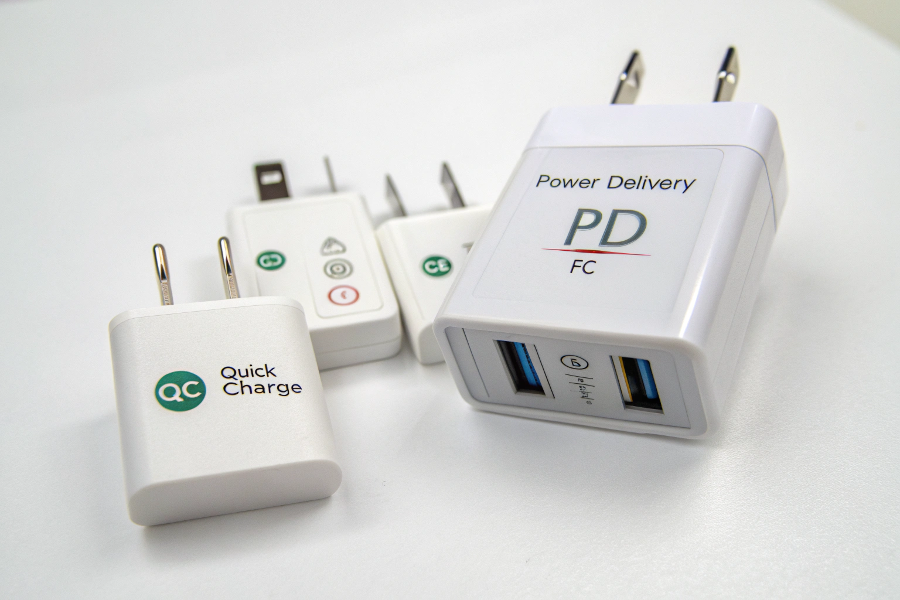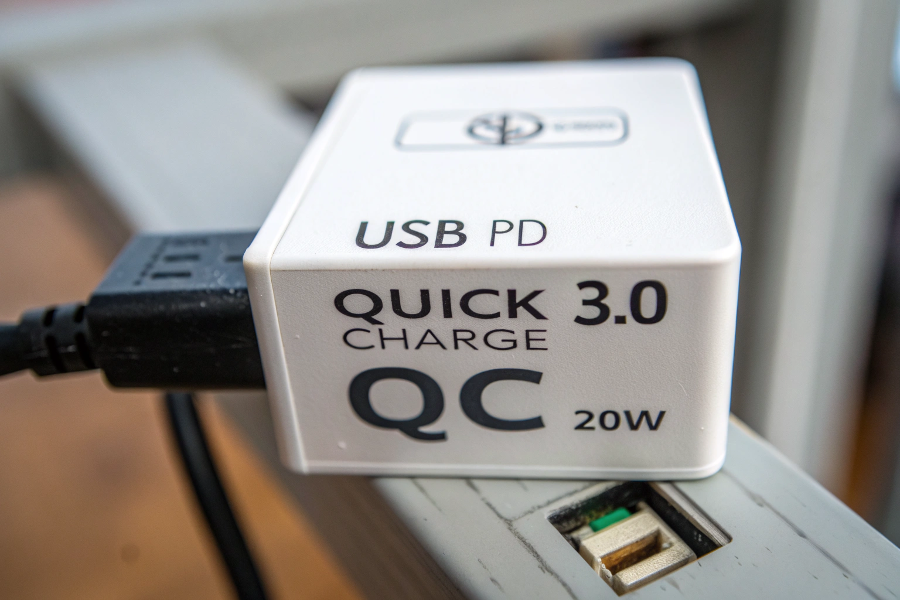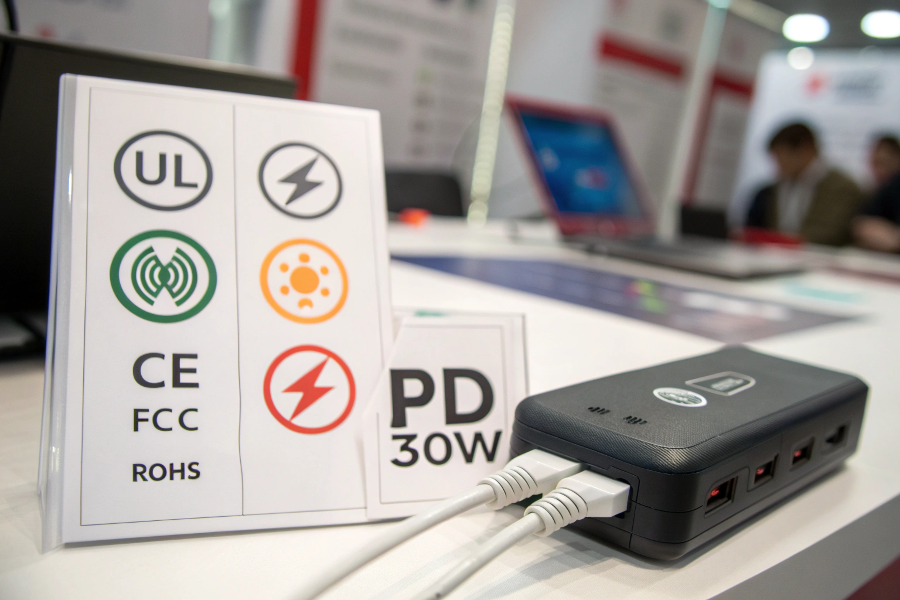Tired of chargers promising speed but leaving your phone battery crawling? With so many chargers out there, picking a truly fast one feels like guesswork. Getting it wrong means wasted time and frustration.
To identify a fast charger, look for specific markings like "Power Delivery" (PD) or "Quick Charge" (QC) logos/text, check the output Wattage (W) – typically 20W or higher for modern phones – and verify safety certifications (like UL, CE, FCC) from reputable brands.

Knowing these key indicators is the first step, but there’s a bit more to it than just glancing at the label. Let’s break down exactly what to look for, ensuring you (and buyers like David) can confidently source and use chargers that deliver real speed.
What markings should I look for on the charger itself?
Staring at the fine print on a charger block and feeling confused by all the symbols and numbers? Choosing based on looks alone often leads to disappointment when your device still charges slowly. Let’s decode those labels.
The most reliable markings indicating fast charging capabilities are "Power Delivery" (or "PD"), "Quick Charge" (or "QC" followed by a version number like 3.0, 4+ etc.), and a clear Wattage (W) rating (e.g., 20W, 30W, 65W). Look for these printed directly on the charger casing.

These specific terms and ratings tell you about the technology inside. Let’s dig a bit deeper into what they mean.
Understanding the Fast Charging Standards
- Power Delivery (PD): This is the most common standard for modern fast charging, especially for Apple devices (iPhone 8 and later) and many Android phones, laptops, and tablets. It primarily uses the USB-C port. If a charger says "PD" or "Power Delivery," it’s designed for faster charging via negotiation between the charger and device. USB PD 3.0 or newer versions (sometimes with PPS – Programmable Power Supply) offer the best compatibility and efficiency.
- Quick Charge (QC): Developed by Qualcomm, this is prevalent in many Android smartphones, particularly those using Snapdragon processors. It often uses the traditional USB-A port (though newer QC versions can use USB-C). Look for the QC logo or text like "Quick Charge 3.0," "QC4+," etc. Different versions offer varying speeds.
Wattage (W) is Key
Regardless of the standard, the Wattage (W)1 tells you the maximum power the charger can output. Higher wattage generally means faster potential charging.
- Baseline: Old standard chargers were often 5W (slow).
- Fast Charging Minimum: For modern smartphones, look for at least 20W. Higher wattages (30W, 45W, 65W+) are common, especially for chargers meant for multiple devices or laptops. Your phone will only draw what it needs, so using a higher wattage charger is safe.
- Multi-Port Chargers: Be careful! Sometimes the advertised wattage (e.g., "65W") is the total combined output. Check the fine print for the per-port output. A 65W charger with three ports might only deliver 20W or 30W from a single port when others are in use.
Here’s a quick reference:
| Marking / Feature | Indicates Fast Charging? | Common Use Cases | Port Type | Minimum for Phone Fast Charge |
|---|---|---|---|---|
| Power Delivery/PD | Yes | iPhones (8+), Pixels, Samsung, Laptops, iPads | USB-C | 20W+ |
| Quick Charge/QC | Yes | Many Android phones (Qualcomm) | USB-A or USB-C | ~18W+ (QC 3.0+) |
| Wattage (W) | Yes (if high enough) | Universal power measure | N/A | 20W+ |
| Standard 5V/1A or 5V/2.4A | No | Older devices, basic charging | USB-A | N/A |
| Brand Logo Only | Maybe (Need more info) | Depends on brand/model | Varies | Check other specs |
Always look for PD or QC branding combined with an adequate Wattage rating.
Beyond the label, what else indicates a fast charger?
Found a charger with "PD" and "30W" printed on it – does that guarantee it’s a good, fast charger? Not always. Markings can sometimes be misleading or outright fake on low-quality products, a real headache for buyers like David dealing with suppliers.
Beyond the label, look for safety certifications (UL, CE, FCC, RoHS)2, consider the brand’s reputation for quality, ensure you have a compatible cable designed for fast charging, and ideally, check reviews or test results if available. These factors provide stronger evidence of a genuine fast charger.

These extra checks help separate the reliable chargers from the questionable ones. Let’s explore why they matter.
Safety Certifications: Non-Negotiable
This is crucial. Reputable fast chargers undergo rigorous testing to ensure they won’t overheat, short circuit, or damage your devices.
- Look for Marks: UL (Underwriters Laboratories – common in North America), CE (Conformité Européenne – Europe), FCC (Federal Communications Commission – US), RoHS (Restriction of Hazardous Substances).
- Why they Matter: They indicate compliance with safety and manufacturing standards. Lack of these symbols is a major red flag. I always emphasize verifying these in my factories – cutting corners here is dangerous. For David, verifying supplier certifications is vital to avoid faulty products and potential liability.
Brand Reputation3 and Source
Is the charger from a well-known, established brand (like Anker, Belkin, Apple, Samsung, or specialized manufacturers like us at FUMEI), or is it a generic, no-name product?
- Trust: Established brands generally have more to lose from poor quality and are more likely to adhere to standards and offer reliable warranties.
- Sourcing: For business buyers, vetting the manufacturer or supplier is key. Ask for test reports and certification documents.
The Right Cable
A fast charger is useless without a capable cable.
- PD Charging: Requires a USB-C to USB-C cable or a USB-C to Lightning cable (MFi certified for iPhones).
- QC Charging: Often uses a USB-A to USB-C or USB-A to Micro-USB cable, but ensure the cable is rated for the higher current.
- Quality: Thin, cheap cables can limit charging speed and wear out quickly.
Performance and Reviews
If possible, check independent reviews or test the charger’s performance yourself (e.g., see if your phone indicates "fast charging," covered next). Real-world results often tell the true story.
| Indicator | Reliability for Fast Charging | Notes |
|---|---|---|
| PD / QC Logo & High Wattage | High | Core technical indicators. |
| Safety Certifications | Very High | Essential for safety and indicates proper manufacturing. |
| Reputable Brand | High | Suggests adherence to standards and quality control. |
| Correct Cable Type | Necessary | Required to enable the fast charging protocol. |
| User Reviews / Tests | Medium to High | Can reveal real-world performance or issues (check source validity). |
| Cheap Price / No Brand | Low | Often correlates with cut corners, lack of safety features, fake specs. |
Combining label checks with these other factors gives you the best chance of identifying a truly fast and safe charger.
Can my phone tell me if it’s fast charging?
Okay, you’ve checked the charger’s labels, wattage, and certifications. But how do you know if it’s actually delivering that fast charge to your phone right now? Sometimes things don’t work as expected.
Yes, most modern smartphones will display a specific notification or icon on the lock screen or status bar when fast charging is active. Look for terms like "Fast charging," "Rapidly charging," "Super Fast Charging," or sometimes a double lightning bolt icon next to the battery indicator.

This visual confirmation from your device is often the final proof you need. Here’s how it typically works:
Common Indicators
The exact wording or symbol varies depending on your phone’s manufacturer and operating system:
- Samsung: Often displays "Fast charging," "Super fast charging," or "Super fast charging 2.0." The charging circle animation might also be a different color (e.g., green or blue).
- Google Pixel: Usually shows "Rapidly charging" on the lock screen.
- iPhones (8 or later with PD): Don’t typically display specific text like "Fast Charging." However, you’ll hear the standard charge confirmation sound, and you can gauge the speed by how quickly the battery percentage increases (expect ~50% in 30 mins from a low state). Some battery widgets might show a slightly different icon, but it’s subtle.
- Other Android Phones (OnePlus, Xiaomi, etc.): May use terms like "Warp Charge," "VOOC Charge," "HyperCharge," or display unique animations or double lightning bolt icons.
Check Battery Settings
Sometimes, more detailed information is available within your phone’s battery settings menu. It might explicitly state the type of charging currently active (e.g., "Charging rapidly").
Using Measurement Apps (Use with Caution)
Apps like Ampere (Android) can measure the approximate current flowing into your battery. Higher current (mA) generally indicates faster charging, but these apps aren’t always perfectly accurate and depend on many factors. They can give a rough idea but aren’t definitive proof of a specific protocol like PD.
Here’s a quick guide to phone indicators:
| Phone Type | Common Fast Charge Indicator(s) | Where to Look |
|---|---|---|
| Samsung Galaxy | "Fast charging," "Super fast charging," Different color animation | Lock screen, Notification shade |
| Google Pixel | "Rapidly charging" | Lock screen, Ambient display |
| iPhone (8+) | Standard charge sound, Rapid % increase, Subtle icon change | Lock screen (observe speed), Battery widget |
| OnePlus | "Warp Charge," "SuperVOOC," Double lightning bolt, Animation | Lock screen, Status bar |
| Xiaomi | "Quick charging," "Mi Turbo Charge," Double lightning bolt | Lock screen, Status bar |
| Other Android | Varies – "Fast Charging," "TurboPower," unique icons/text | Lock screen, Status bar, Settings |
If your phone shows one of these indicators when connected to the charger, you can be confident it’s receiving a fast charge.
Conclusion
Identifying a fast charger involves checking for PD or QC markings, confirming a high wattage (20W+), verifying safety certifications, using a quality cable, and seeing if your phone confirms the fast charge status. Trust reputable brands and verified suppliers.
-
Understanding Wattage (W) is crucial for selecting the right charger for fast charging. Explore this link to learn more about its significance. ↩
-
Safety certifications ensure that chargers meet safety standards, preventing hazards. Discover why these certifications matter for your devices. ↩
-
A reputable brand often indicates better quality and safety standards. Learn more about the importance of brand reputation in charger selection. ↩
